Ira S. Bowen

Ira Bowen (right) in the lab with Robert Millikan. AIP Emilio Segrè Visual Archives
Ira S. Bowen was born in Seneca Falls, New York in 1898. Due to frequent moves of his family, he was home schooled until the death of his father in 1908. From that point on he attended the Houghton College where his mother worked as teacher. After graduation from high school in 1915, Bowen stayed at the junior college of Houghton College and later joined Oberlin College from which he graduated in 1919. During the time at Oberlin College, Bowen did some research on the properties of steel together with the scientist Robert Hadfield.
Bowen started studying physics at the University of Chicago in fall 1919. In 1921, Bowen took a position in the research group of Robert Andrews Millikan. He was assigned to do ultraviolet spectroscopy of chemical elements. Millikan was persuaded by George Ellery Hale to move to the California Institute of Technology in 1921, and Bowen moved with him. The contact with Hale enabled Bowen also to work at the Mount Wilson Observatory and the Palomar Observatory. Bowen gave lectures on general physics at Caltech and did research on cosmic rays and followed his studies on UV spectroscopy. He also did calculations on spectra for the light elements of the periodic table. With that data and the inspiration from a chapter on gaseous nebula and the emission of radiation at low density in the book Astronomy by Henry Norris Russell, Raymond Smith Dugan, and John Quincy Stewart, he achieved his best known discovery.
The green emission lines of the Cat's Eye Nebula at 4959 and 5007 Ångström were discovered by William Huggins in 1864. Because no known element was showing these emission lines in the experiment it was concluded in the late 1890s that a new element was responsible for that lines, it was called nebulium. Bowen was able to calculate the forbidden transitions of doubly ionized oxygen to be exactly where the lines had been found. The low probability for collisions in the nebula made it impossible for the oxygen to get from the excited stated to the ground state and so the forbidden transitions were the main path for the relaxation. Bowen published his findings in 1927 and concluded that nebulium was not really a chemical element. Bowen was the first director of the Palomar Observatory, serving from 1948 to 1964. Before his retirement in 1964 and even afterwards Bowen was involved in the improvement of the optical design of several large optical instruments. He is also known in the context of meteorology for the introduction of the Bowen ratio, which quantifies the ratio of sensible to latent heat over an evaporating surface.
Bowen was elected to the U.S. National Academy of Sciences in 1936 and was awarded its Henry Draper Medal in 1942. He was the 1946 recipient of the Howard N. Potts Medal, the 1949 recipient of the Rumford Prize of the American Academy of Arts and Sciences, the 1952 recipient of the OSA Frederic Ives Medal, the 1957 recipient of the Bruce Medal, the 1964 Henry Norris Russell lecturer, and the 1966 recipient of the Gold Medal of the Royal Astronomical Society.
Bowen passed away in 1973.
Document Created: 26 Jul 2023
Last Updated: 28 Aug 2023
